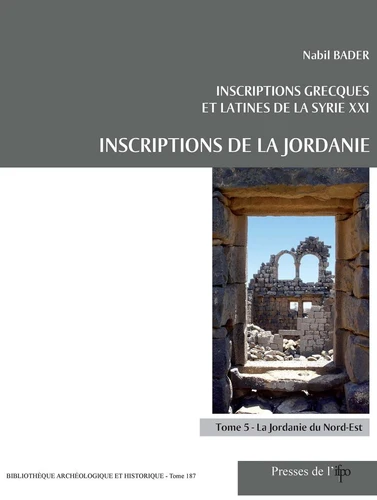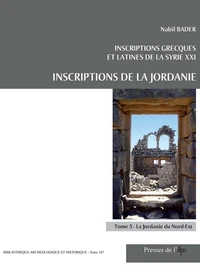Inscriptions grecques et latines de la Syrie. Tome 21, Inscriptions de la Jordanie Tome 5, La Jordanie du Nord-Est
Par :Formats :
Disponible dans votre compte client Decitre ou Furet du Nord dès validation de votre commande. Le format PDF est :
- Compatible avec une lecture sur My Vivlio (smartphone, tablette, ordinateur)
- Compatible avec une lecture sur liseuses Vivlio
- Pour les liseuses autres que Vivlio, vous devez utiliser le logiciel Adobe Digital Edition. Non compatible avec la lecture sur les liseuses Kindle, Remarkable et Sony
 , qui est-ce ?
, qui est-ce ?Notre partenaire de plateforme de lecture numérique où vous retrouverez l'ensemble de vos ebooks gratuitement
Pour en savoir plus sur nos ebooks, consultez notre aide en ligne ici
- Nombre de pages380
- FormatPDF
- ISBN978-2-35159-284-7
- EAN9782351592847
- Date de parution01/01/2009
- Copier Coller01 page(s) autorisée(s)
- Protection num.Digital Watermarking
- Taille14 Mo
- Transferts max.Autorisé
- Infos supplémentairesPDF avec Watermark
- ÉditeurIFPO
Résumé
Le cinquième volume du corpus des inscriptions grecques et latines de la Jordanie réunit 747 inscriptions provenant de dix-huit sites de la région nord-est, dont un site - Umm al-Jimal - totalise à lui seul 537 numéros ! L'ouvrage comprend une introduction générale, une introduction historique, des notes sur les voyageurs, et le corpus dans lequel les inscriptions sont classées selon leur localisation, d'ouest en est.
Pour chaque site, les inscriptions sont présentées selon leur date et leur nature. C'est une épigraphie très diversifiée : inscriptions païennes, inscriptions chrétiennes, inscriptions des équipes de sport, édits des empereurs, inscriptions honorifiques, inscriptions commémorant les constructions, et inscriptions funéraires, qui sont de loin les plus nombreuses. L'épigraphie régionale est principalement de langue grecque ; signalons aussi quelques inscriptions latines et deux bilingues.
Peu de pierres inscrites sont encore in situ. Les inscriptions datées couvrent un arc chronologique de près de cinq siècles (177-646 ap. J.-C.) This study presents the results of a survey and a collection of Greek and Latin inscriptions from the north east area of Jordan. Representing the fifth Volume of the Corpus of Greek and Latin inscriptions in Jordan, this study consists of 747 inscriptions collected from two sources: published scientific references and field work which enabled us to uncover more inscriptions.
The inscriptions were found in eighteen sites, the most important of which was Umm al-Jimal with 537 inscriptions. The study includes a general introduction, a historical introduction, general remarks about inscriptions, notes about travelers and explorers, notes about the inscribed stones and the contents of the inscriptions, and finally, the Corpus which represents the largest part of the research.
The inscriptions in the Corpus are organized in a geographical order from west to east. The inscriptions from each site are arranged according to their subject matter and according to their date, the oldest coming first. The subjects of the inscriptions were numerous: Pagan inscriptions, Christian inscriptions, sport teams' inscriptions, emperors' edicts, honorific inscriptions, inscriptions commemorating constructions, and funerary inscriptions, which are the most numerous.
Most of the inscriptions were in Greek, some were in Latin, and two were bilingual. What is worth noting is that the stones on which the inscriptions were made were moved from their original place either to a new place within the same site or to another site. As for dating these inscriptions, it was found that the few dated ones covered the period from 177AD to 646 AD.
Pour chaque site, les inscriptions sont présentées selon leur date et leur nature. C'est une épigraphie très diversifiée : inscriptions païennes, inscriptions chrétiennes, inscriptions des équipes de sport, édits des empereurs, inscriptions honorifiques, inscriptions commémorant les constructions, et inscriptions funéraires, qui sont de loin les plus nombreuses. L'épigraphie régionale est principalement de langue grecque ; signalons aussi quelques inscriptions latines et deux bilingues.
Peu de pierres inscrites sont encore in situ. Les inscriptions datées couvrent un arc chronologique de près de cinq siècles (177-646 ap. J.-C.) This study presents the results of a survey and a collection of Greek and Latin inscriptions from the north east area of Jordan. Representing the fifth Volume of the Corpus of Greek and Latin inscriptions in Jordan, this study consists of 747 inscriptions collected from two sources: published scientific references and field work which enabled us to uncover more inscriptions.
The inscriptions were found in eighteen sites, the most important of which was Umm al-Jimal with 537 inscriptions. The study includes a general introduction, a historical introduction, general remarks about inscriptions, notes about travelers and explorers, notes about the inscribed stones and the contents of the inscriptions, and finally, the Corpus which represents the largest part of the research.
The inscriptions in the Corpus are organized in a geographical order from west to east. The inscriptions from each site are arranged according to their subject matter and according to their date, the oldest coming first. The subjects of the inscriptions were numerous: Pagan inscriptions, Christian inscriptions, sport teams' inscriptions, emperors' edicts, honorific inscriptions, inscriptions commemorating constructions, and funerary inscriptions, which are the most numerous.
Most of the inscriptions were in Greek, some were in Latin, and two were bilingual. What is worth noting is that the stones on which the inscriptions were made were moved from their original place either to a new place within the same site or to another site. As for dating these inscriptions, it was found that the few dated ones covered the period from 177AD to 646 AD.
Le cinquième volume du corpus des inscriptions grecques et latines de la Jordanie réunit 747 inscriptions provenant de dix-huit sites de la région nord-est, dont un site - Umm al-Jimal - totalise à lui seul 537 numéros ! L'ouvrage comprend une introduction générale, une introduction historique, des notes sur les voyageurs, et le corpus dans lequel les inscriptions sont classées selon leur localisation, d'ouest en est.
Pour chaque site, les inscriptions sont présentées selon leur date et leur nature. C'est une épigraphie très diversifiée : inscriptions païennes, inscriptions chrétiennes, inscriptions des équipes de sport, édits des empereurs, inscriptions honorifiques, inscriptions commémorant les constructions, et inscriptions funéraires, qui sont de loin les plus nombreuses. L'épigraphie régionale est principalement de langue grecque ; signalons aussi quelques inscriptions latines et deux bilingues.
Peu de pierres inscrites sont encore in situ. Les inscriptions datées couvrent un arc chronologique de près de cinq siècles (177-646 ap. J.-C.) This study presents the results of a survey and a collection of Greek and Latin inscriptions from the north east area of Jordan. Representing the fifth Volume of the Corpus of Greek and Latin inscriptions in Jordan, this study consists of 747 inscriptions collected from two sources: published scientific references and field work which enabled us to uncover more inscriptions.
The inscriptions were found in eighteen sites, the most important of which was Umm al-Jimal with 537 inscriptions. The study includes a general introduction, a historical introduction, general remarks about inscriptions, notes about travelers and explorers, notes about the inscribed stones and the contents of the inscriptions, and finally, the Corpus which represents the largest part of the research.
The inscriptions in the Corpus are organized in a geographical order from west to east. The inscriptions from each site are arranged according to their subject matter and according to their date, the oldest coming first. The subjects of the inscriptions were numerous: Pagan inscriptions, Christian inscriptions, sport teams' inscriptions, emperors' edicts, honorific inscriptions, inscriptions commemorating constructions, and funerary inscriptions, which are the most numerous.
Most of the inscriptions were in Greek, some were in Latin, and two were bilingual. What is worth noting is that the stones on which the inscriptions were made were moved from their original place either to a new place within the same site or to another site. As for dating these inscriptions, it was found that the few dated ones covered the period from 177AD to 646 AD.
Pour chaque site, les inscriptions sont présentées selon leur date et leur nature. C'est une épigraphie très diversifiée : inscriptions païennes, inscriptions chrétiennes, inscriptions des équipes de sport, édits des empereurs, inscriptions honorifiques, inscriptions commémorant les constructions, et inscriptions funéraires, qui sont de loin les plus nombreuses. L'épigraphie régionale est principalement de langue grecque ; signalons aussi quelques inscriptions latines et deux bilingues.
Peu de pierres inscrites sont encore in situ. Les inscriptions datées couvrent un arc chronologique de près de cinq siècles (177-646 ap. J.-C.) This study presents the results of a survey and a collection of Greek and Latin inscriptions from the north east area of Jordan. Representing the fifth Volume of the Corpus of Greek and Latin inscriptions in Jordan, this study consists of 747 inscriptions collected from two sources: published scientific references and field work which enabled us to uncover more inscriptions.
The inscriptions were found in eighteen sites, the most important of which was Umm al-Jimal with 537 inscriptions. The study includes a general introduction, a historical introduction, general remarks about inscriptions, notes about travelers and explorers, notes about the inscribed stones and the contents of the inscriptions, and finally, the Corpus which represents the largest part of the research.
The inscriptions in the Corpus are organized in a geographical order from west to east. The inscriptions from each site are arranged according to their subject matter and according to their date, the oldest coming first. The subjects of the inscriptions were numerous: Pagan inscriptions, Christian inscriptions, sport teams' inscriptions, emperors' edicts, honorific inscriptions, inscriptions commemorating constructions, and funerary inscriptions, which are the most numerous.
Most of the inscriptions were in Greek, some were in Latin, and two were bilingual. What is worth noting is that the stones on which the inscriptions were made were moved from their original place either to a new place within the same site or to another site. As for dating these inscriptions, it was found that the few dated ones covered the period from 177AD to 646 AD.




